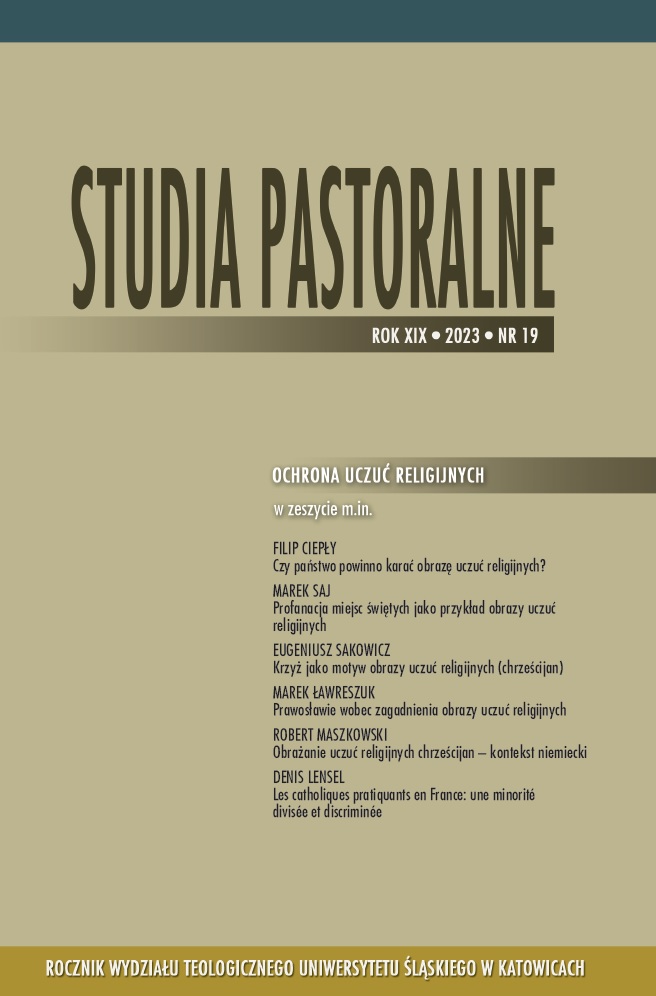I. Dokumenty
Konstytucja Rzeczypospolitej Polskiej z dnia 2 kwietnia 1997 (Dz.U. 1997, nr 78), https://isap.sejm.gov.pl/isap.nsf/download.xsp/WDU19970780483/U/D19970483Lj.pdf [dostęp: 25.11.2022]
Ustawa z dnia 6 czerwca 1997 r. Kodeks karny, Dz.U. 1997 nr 88, poz. 553, https://isap.sejm.gov.pl/isap.nsf/download.xsp/WDU19970880553/U/D19970553Lj.pdf [dostęp: 30.09.2022].
Sakowicz E., Ekspertyza spektaklu teatralnego: Olivier Frljić, „Klątwa” [dla Prokuratury Okręgowej Warszawa-Praga w Warszawie, 29 maja 2018 r.], passim.
Sakowicz E., Ekspertyza spektaklu teatralnego: Olivier Frljić, „Nasza przemoc i wasza przemoc” [dla Prokuratury Rejonowej Bydgoszcz-Północ, 2 września 2017 r.], s. 5-6.
II. Obraza uczuć religijnych, „Ateneum Kapłańskie” 178 (2022) z. 3, s. 420-536
Bielecki M., Ochrona uczuć religijnych w polskim systemie edukacji, „Ateneum Kapłańskie” 178 (2022) z. 3, s. 474-485.
Ciepły F., Współczesne problemy dotyczące kryminalizacji obrazy uczuć religijnych, „Ate-neum Kapłańskie” 178 (2022) z. 3, s. 494-503.
Kręcidło J., Czy Jezus obrażał uczucia religijne pobożnych żydów?, „Ateneum Kapłańskie” 178 (2022) z. 3, s. 448-460.
Maszkowki R., Kilka uwag o obrażaniu uczuć religijnych chrześcijan w Niemczech, „Atene-um Kapłańskie” 178 (2022) z. 3, s. 504-520.
Saj M., Profanacja miejsc świętych jako przykład obrazy uczuć religijnych, „Ateneum Ka-płańskie” 178 (2022) z. 3, s. 486-493.
Sakowicz E., Ochrona uczuć religijnych w przestrzeni publicznej?, „Ateneum Kapłańskie” 178 (2022) z. 3, s. 461-473.
Sakowicz E., Wprowadzenie, „Ateneum Kapłańskie” 178 (2022) z. 3, s. 424-427.
Sakowicz E., Szuppe P., Obraza uczuć religijnych. Bibliografia, „Ateneum Kapłańskie” 178 (2022) z. 3, s. 527-536.
Słowo wstępne bp. Artura G. Mizińskiego, Sekretarza Generalnego Konferencji Episkopatu Polski, „Ateneum Kapłańskie” 178 (2022) z. 3, s. 420-427.
Stabryła W.M., „[...] wiele złego dokonali [...]” (1 Mch 1,52). Przejawy bezczeszczenia i jego sprawcy, „Ateneum Kapłańskie” 178 (2022) z. 3, s. 428-447.
Witko K., „Bóg się sam obroni! Nie potrzebuje do tego sali sejmowej”. Pobieżne i przelotne spojrzenie znad Sekwany na problematykę obrazy uczuć religijnych, „Ateneum Ka-płańskie” 178 (2022) z. 3, s. 521-526.
III. Literatura przedmiotu
Batory A., Uczucia. 1. Aspekt psychologiczny: w: Encyklopedia katolicka, t. 19, red. E. Gigi-lewicz, Lublin 2013, kol. 1281.
Budyn-Kulik M., Znieważenie uczuć religijnych – analiza dogmatyczna i praktyka ścigania, „Prawo w Działaniu. Sprawy Karne” 19 (2014), s. 100-137.
Cebula S., Obraza uczuć religijnych, czyli kontrowersje wokół artykułu 196 kodeksu karnego, „Studia Religiologica” 45 (2012) nr 4, s. 293-300.
Ciepły F., Satyra i karykatura wobec wartości religijnych w świetle przepisów prawa praso-wego, w: Odpowiedzialność karna artysty za obrazę uczuć religijnych, red. Tenże, Warszawa 2014, s. 211-221.
Czarnek P., Konstytucyjne granice wolności twórczości artystycznej w kontekście prawa do ochrony uczuć religijnych, w: Odpowiedzialność karna artysty za obrazę uczuć re-ligijnych, red. F. Ciepły, Warszawa 2014, s. 81-90.
Derlatka M., Zasadność kryminalizacji obrazy uczuć religijnych, „Prokuratura i Prawo” 2015, nr 10, s. 41-46.
Dziwisz S., Ochrona uczuć religijnych w polskim prawie karnym, Lublin 2019.
Hyś S., Komentarz do artykułu 196 Kodeksu karnego, w: Kodeks karny. Komentarz, red. A. Grześkowiak, K. Wiak, Warszawa 2015, s. 976.
Janyga W., Komentarz do artykułu 196 Kodeksu karnego, w: Kodeks karny. Część szczegó-łowa. Komentarz, red. M. Królikowski, R. Zabłocki, Warszawa 2013, s. 592.
Janyga W., Przestępstwo obrazy uczuć religijnych w polskim prawie karnym w świetle współ-czesnego pojmowania wolności sumienia i wyznania, Warszawa 2010.
Krzyż, red. E. Kasjaniuk, Lublin 2011.
Katechizm Kościoła katolickiego, Poznań 1994.
Kotas S., Lewandowska P., Ochrona uczuć religijnych a wolność wypowiedzi, Warszawa 2017, https://iws.gov.pl/wp-content/uploads/2018/08/kolor_IWS_Kotas-S.-Lewandowska-P._Ochrona-uczu%C4%87-religijnych.pdf [dostęp: 25.11.2022].
Kozielewicz W., Orzecznictwo Sądu Najwyższego w sprawach o przestępstwo obrazy uczuć religijnych, w: Odpowiedzialność karna artysty za obrazę uczuć religijnych, red. F. Ciepły, Warszawa 2014, s. 161-180.
Kruczoń E., Przestępstwo obrazy uczuć religijnych, „Prokuratura i Prawo” 2011, nr 2, s. 38-59.
Makarewicz B., Kara więzienia za „wyszydzanie Kościoła”? Jest projekt zmiany Kodeksu karnego, https://wiadomosci.radiozet.pl/Polska/Polityka/Kara-wiezienia-za-wyszydzanie-Kosciola-Jest-projekt-zmiany-Kodeksu-karnego?rzs=najnowsze [dostęp: 26.07.2022].
Nienałtowska K., Zalewski B., Ochrona uczuć religijnych w wybranych państwach Europy. Analiza prawnoporównawcza z uwzględnieniem orzecznictwa Europejskiego Trybu-nału Praw Człowieka, https://ordoiuris.pl/wolnosc-sumienia/ochrona-uczuc-religijnych-w-wybranych-panstwach-europy-analiza-prawnoporownawcza-z [data publikacji: 23.05.2019; dostęp: 29.08.2022].
Odpowiedzialność karna artysty za obrazę uczuć religijnych, red. F. Ciepły, Warszawa 2014.
Sakowicz E., Jak skutecznie chronić uczucia religijne?, „Niedziela” [Ogólnopolska] 2022, nr 6, s. 14-15.
Sakowicz E., Krzyż Jezusa Chrystusa nie jest „atrapą” ani „przedmiotem przypominającym krzyż”. O krzyżu jako motywie obrazy uczuć religijnych, „Ateneum Kapłańskie” 181 (2023), z. 3, s. 530-546.
Sakowicz E., Przestępstwo obrazy uczuć religijnych wobec dzieci i młodzieży, w: Przestęp-czość przeciwko rodzinie i opiece w ujęciu teoretyczno-empirycznym, red. B.M. Kał-don, Warszawa 2023, s. 103-117.
Sakowicz E., Religia – „ufantastycznione odbicie realnego świata”. Negacja religii i kultu przez system komunistyczny w powojennej Polsce, w: Potrzeba religii. Dynamika praktyk religijnych i rytualnych, red. Z. Kupisiński, Lublin 2017, s. 85–104.
Sakowicz E., Solidarnie w obronie religii, „Niedziela” [Ogólnopolska] 2021, nr 39, s. 14-16.
Sakowicz E., Wprowadzenie [do bloku tematycznego „Krzyż”], „Ateneum Kapłańskie” 180 (2023) z 1, s. 5-9.
Krzyż [Część] I., red. E. Sakowicz, „Ateneum Kapłańskie” 180 (2023) z 1, s. 1-86.
Salij J., Krzyż, w: Katolicyzm A-Z, red. Z. Pawlak, Poznań 1982, s. 224-225.
Obecność krzyża w przestrzeni publicznej. Doświadczenia niektórych państw europejskich, red. P. Stanisz, M. Zawiślak, M. Ordon, Lublin 2016.
Szczęsny M., Obraza uczuć religijnych. Czym są uczucia religijne?, https://kruczek.pl/obraza-uczuc-religijnych-uczucia-religijne-i-wolnosc-slowa/ [do-stęp: 25.11.2022].
Seminarium „Ekspresja religijna versus wolność słowa”, Instytut Wymiaru Sprawiedliwości w Warszawie, 2 marca 2022 r., https://www.facebook.com/IWSGOVPL/ [dostęp: 25.11.2022].
Google Scholar


